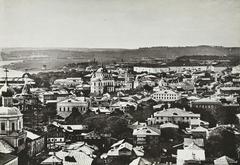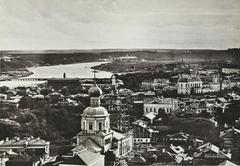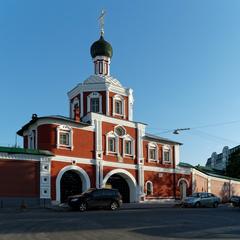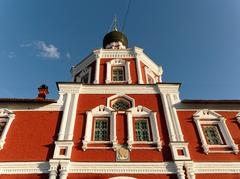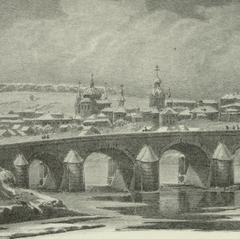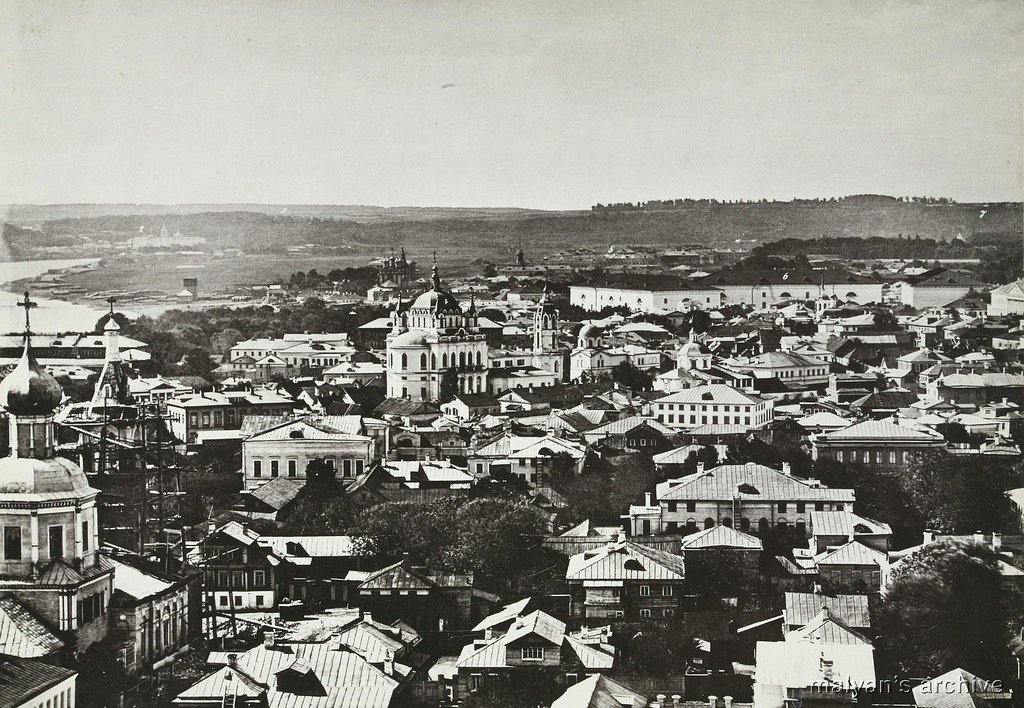
Conception Convent Moscow: Visiting Hours, Tickets, and Historical Sites Guide
Date: 15/06/2025
Introduction
Nestled along the banks of the Moskva River in the historic Khamovniki District, the Conception Convent (Zachatyevsky Monastery) is not only Moscow’s oldest female monastic institution but also a vibrant symbol of Russian Orthodox heritage and resilience. Founded in 1360 by St. Alexy, Metropolitan of Moscow, the convent has withstood centuries of growth, turmoil, destruction, and revival, reflecting the broader currents of Russian history. Its legacy, tightly woven with traditions of motherhood and Marian devotion, continues to draw pilgrims and travelers seeking spiritual blessings, historical context, and architectural beauty (OrthoChristian; Life-Cheb; Tripomatic; Greatphis).
Table of Contents
- Foundation and Early History (14th–16th Centuries)
- Reestablishment and Expansion (Late 16th–17th Centuries)
- Religious and Cultural Significance
- 20th Century Destruction and Soviet Suppression
- Revival and Restoration (1990s–Present)
- Canonizations and Notable Events
- Architectural Evolution
- Practical Information for Visitors
- Frequently Asked Questions (FAQ)
- Travel Tips
- Visuals and Media
- Explore More
- References and Links
Foundation and Early History (14th–16th Centuries)
Founded in 1360 by St. Alexy, Metropolitan of Moscow, the Conception Convent began as a humble wooden church dedicated to the Conception of Righteous Anna, mother of the Virgin Mary. The first nuns were St. Alexy’s sisters, Juliania and Eupraxia, later canonized by the Russian Orthodox Church. The convent quickly established itself as a center of spiritual life, but a devastating fire in 1547 forced the community to relocate closer to the Kremlin. Despite this setback, a monastic presence endured at the original site, preserving its sacred legacy (OrthoChristian; Life-Cheb).
Reestablishment and Expansion (Late 16th–17th Centuries)
The convent was formally reestablished at its historic location in 1584 under the patronage of Tsar Feodor Ioannovich. This era was marked by architectural and spiritual growth, with new brick churches replacing earlier wooden structures. Key additions included the Church of the Conception of Righteous Anna with chapels for Martyr Theodore Stratelates and Martyr Irina, as well as a refectory church honoring the Nativity of the Virgin Mary. The convent’s architecture began to reflect the evolving Moscow style, incorporating features such as corbel arches (kokoshniks) and later Moscow Baroque elements (Wikipedia: Architecture of Russia).
Religious and Cultural Significance
The Conception Convent holds stauropegic status, being directly subordinate to the Patriarch of Moscow, which underscores its prominence in Russian Orthodoxy (Tripomatic). It has long served as a spiritual refuge for women, especially those praying for fertility and motherhood. The convent houses treasured relics, notably the Belt of the Blessed Virgin Mary, and the revered icon of the Mother of God “Merciful”—both central to its tradition of intercessory prayer.
20th Century Destruction and Soviet Suppression
The Bolshevik Revolution brought severe hardship. The convent was closed in 1918, its buildings were confiscated, and many nuns faced persecution. Landmark structures, including the Cathedral Church of the Nativity of the Blessed Virgin Mary and the bell tower, were demolished in the 1930s. The grounds were repurposed as a school, and sacred objects were scattered or transferred to other churches. The icon of the Mother of God “Merciful” was only returned to the convent in 1999 after decades of displacement (Life-Cheb).
Revival and Restoration (1990s–Present)
The fall of the Soviet Union enabled the Russian Orthodox Church to reclaim and revive the convent. In 1991, a new sisterhood was established, and regular worship resumed by 1993. The convent regained its stauropegic status in 1995. Restoration projects rebuilt the destroyed churches, including the Church of the Conception of Righteous Anna and the Church of the Descent of the Holy Spirit. The Soviet-era school was demolished, making way for authentic monastic structures. Today, the convent supports a range of charitable activities, including a shelter, bakery, sewing workshop, and library. Its ensemble of historic buildings, gardens, and spiritual life has been largely restored (OrthoChristian; Life-Cheb).
Canonizations and Notable Events
Significant events in recent decades include the 2001 canonization of Juliania and Eupraxia and the return of the icon of the Mother of God “Merciful.” In 2005, the convent hosted relics of Saints Cyprian and Justina before their return to Cyprus (Mospat).
Architectural Evolution
The architecture of the Conception Convent has evolved through several key phases:
- Medieval Wooden Structures: Early timber churches and monastic buildings.
- Moscow Baroque and Naryshkin Baroque: The 17th-century gate church reflects decorative brickwork, pilasters, and ornate domes (Wikipedia: Architecture of Russia).
- 19th Century Russian Gothic: The demolished Kazakov-designed cathedral once showcased pointed arches and soaring towers.
- 21st Century Reconstruction: The new five-domed Cathedral of the Nativity of Our Lady, consecrated in 2010, blends traditional forms with modern construction.
The convent’s ensemble today features restored walls, corner towers, tranquil gardens, and richly decorated interiors with vibrant iconography (Tripomatic).
Practical Information for Visitors
Location and Access
- Address: 2nd Zachatyevsky Lane, Building 2, Khamovniki District, Moscow, Russia, 119034
- Metro: Kropotkinskaya (Red Line), Park Kultury (Circle and Red Lines) (Travel Like a Boss)
Visiting Hours
- General Opening: Daily, 8:00 AM – 7:00 PM
- Note: Hours may vary on major Orthodox holidays or during special services. Check official sources for updates.
Tickets and Donations
- Admission: Free
- Donations: Welcome for restoration and charity projects
- Guided Tours: Available by prior booking; fees may apply (Express to Russia)
Accessibility
- Wheelchair Access: Partial, with ramps at main entrances; some historic areas may have limited access
- Facilities: Basic restrooms; limited amenities
Guided Tours
- Available in Russian and English; book in advance via the convent or reputable agencies (Express to Russia)
Dress Code & Etiquette
- Women: Skirts/dresses covering the knees and headscarves recommended
- Men: Avoid shorts and sleeveless shirts
- Behavior: Silence and respectful conduct expected, especially during services
- Photography: Allowed in outdoor areas; photography inside churches requires permission. No flash or tripods during services.
Getting There
- By Metro: Short walk from Kropotkinskaya or Park Kultury stations
- Public Transport: Troika card recommended for discounted fares (Indore Pioneer)
- Taxi/Ride-hailing: Yandex.Taxi is widely available; allow extra time for city traffic
Nearby Attractions
- Pushkin Museum of Fine Arts
- Gorky Park
- Cathedral of Christ the Savior
- Tolstoy House Museum
- Tretyakov Gallery
Frequently Asked Questions (FAQ)
Q: What are the Conception Convent visiting hours?
A: 8:00 AM – 7:00 PM daily; may vary on holidays.
Q: Is there an entrance fee or ticket required?
A: No, entry is free. Donations are appreciated.
Q: Are guided tours available?
A: Yes, in Russian and English; book in advance.
Q: Is the convent accessible for wheelchair users?
A: Yes, partially. Some historic areas may not be fully accessible.
Q: What is the dress code?
A: Modest clothing required. Women should cover heads and knees; men should avoid shorts and sleeveless tops.
Q: Can I take photographs?
A: Permitted outdoors; ask permission for interior photos and during services.
Q: How do I get there by public transport?
A: Nearest metro stations: Kropotkinskaya and Park Kultury. Both are a 10–15 minute walk away.
Travel Tips
- Footwear: Comfortable shoes are essential due to cobblestone paths (Indore Pioneer).
- Weather: Prepare for variable weather—bring layers, an umbrella, or a raincoat as needed.
- Language: Russian is the primary language; translation apps or a guidebook can be helpful (Travel Like a Boss).
- Cash: Donations and candle purchases are usually cash-only.
- Health & Safety: Central Moscow is generally safe, but exercise normal precautions (Travellers Worldwide).
Visuals and Media
Image: The Conception Convent, highlighting its historic architecture and serene atmosphere.
Map of Conception Convent Location
High-quality visuals and virtual tours are available on the convent’s official website and major travel portals. Suggested alt text: “Conception Convent exterior view,” “Interior of the Church of the Conception of Righteous Anna,” and “Icon of the Mother of God Merciful at Conception Convent.”
Explore More
For further reading, visit the official Wikipedia page and the Moscow city tourism portal.
Summary and Recommendations
The Conception Convent is a testament to Moscow’s spiritual depth, architectural grandeur, and enduring cultural legacy. With free access, a welcoming atmosphere, and proximity to other major attractions, it is an essential addition to any Moscow itinerary. Respectful attire and behavior ensure a meaningful experience, whether you join a service, explore the tranquil gardens, or learn about the convent’s storied past.
For the latest updates, guided tour bookings, and visitor advisories, consult official convent and tourism platforms. Download the Audiala app for expert-guided experiences and follow social media for travel tips and news.
